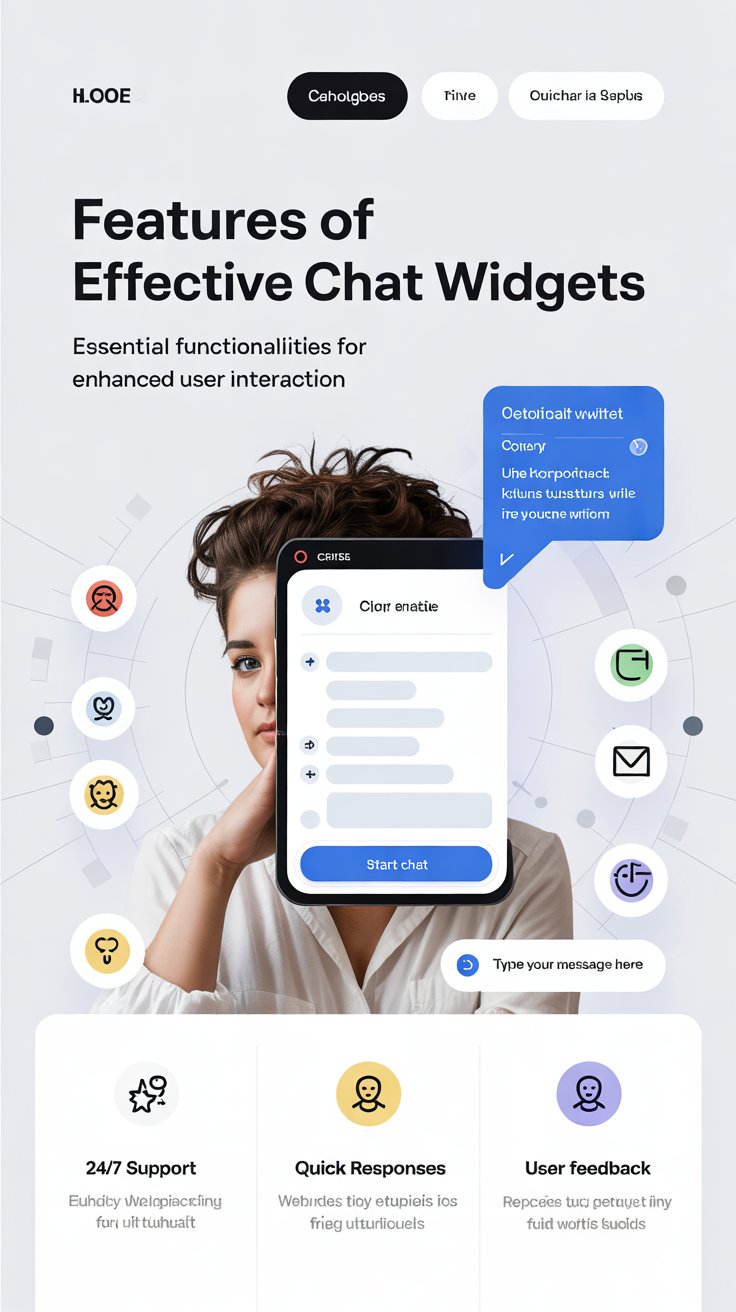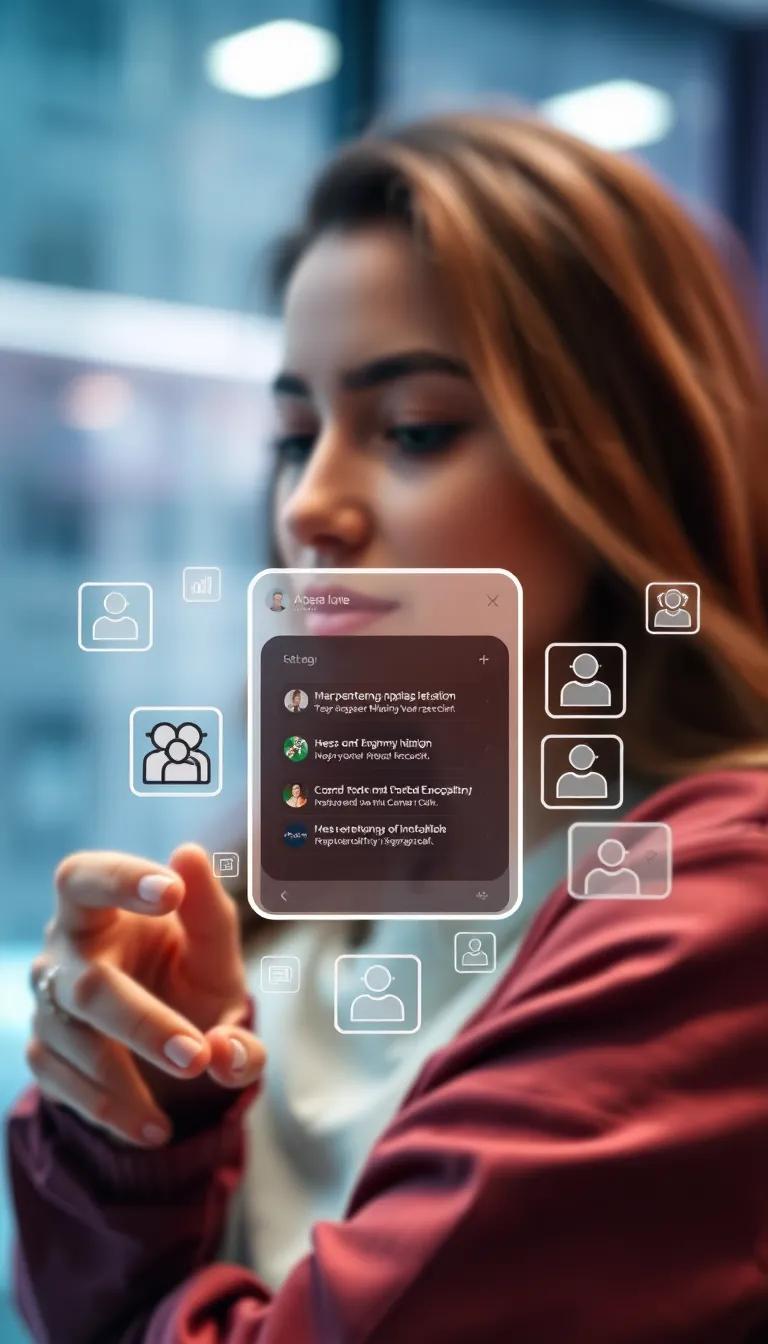Introduction
Engagement chat has emerged as a pivotal tool for businesses, improving the way they interact with website visitors. This increasingly popular method allows for real-time communication, making it easier for companies to address customer queries, provide immediate support, and ultimately enhance the user experience. By implementing effective engagement chat tactics, companies can leverage their free website chat widgets to foster stronger relationships with their audiences and drive higher conversion rates.
We will explore various engagement chat tactics that not only optimize customer service but also increase user satisfaction. We will delve into the features and functionalities of chat widgets, discuss best practices for engaging with users, and highlight the importance of analytics in refining chat strategies. Understanding these elements can significantly enhance a business’s online presence and its capacity to convert visitors into loyal customers.
Understanding Engagement Chat The Significance of Engagement Chat in Modern Customer Service
Engagement chat refers to proactive and interactive communication methods deployed through chat interfaces, particularly on websites. This concept emerged alongside advancements in digital communication technologies, driven by the need for businesses to provide immediate, personalized support to customers. Its significance lies in its ability to foster deeper connections between customers and brands, enhancing overall satisfaction and loyalty.
At its core, engagement chat enables businesses to initiate conversations with users in real-time, addressing inquiries, guiding them through complex processes, and resolving issues as they arise. Unlike traditional customer support methods, which may rely heavily on email or phone interactions that can create delays, engagement chat offers instant communication. This immediacy enhances user experience by providing answers when they are most needed, thereby reducing friction in the customer journey.
The advantages of engagement chat are manifold. For one, it allows for a more human touch in digital interactions. Customers feel valued when their questions are answered swiftly and accurately, contributing to a sense of being heard and understood. Engagement chat tools often utilize conversational interfaces powered by natural language processing, making interactions more intuitive and user-friendly.
Engagement chat significantly improves operational efficiency for businesses. Automated responses can handle common inquiries, freeing up human agents to tackle more complex issues. This bifurcation of labor not only optimizes resource allocation but also enhances service quality, as customers receive quicker responses without sacrificing the depth of assistance available.
Another important aspect of engagement chat is its role in gathering analytics and insights. With each interaction, businesses can collect data on customer preferences, frequently asked questions, and overall satisfaction levels. This information is invaluable in assessing how well services are meeting customer needs and allows for continuous improvement.
The advent of engagement chat represents a paradigm shift in customer service, transforming static support into dynamic, interactive experiences. The evolution from traditional support methods to engagement chat systems is necessary for businesses aiming to stay relevant in a competitive marketplace and respond effectively to the ever-changing demands of modern consumers.
Features of Effective Chat Widgets Essential Functionalities for Enhanced User Interaction
To foster meaningful customer engagement, the implementation of effective chat widgets on a website is paramount. These tools not only facilitate immediate responses but also contribute to the overall user experience. A well-designed chat widget should incorporate several key features that enhance interaction, ensuring users feel valued and understood.
Automated Responses for Immediate Engagement
The ability to provide automated responses is a crucial feature that can significantly enhance user experience. When a user initiates a chat, receiving an instant reply, even if it is an automated message, serves to acknowledge their presence and concerns. This can reduce wait times and increase customer satisfaction. Automated systems can be programmed with frequently asked questions, allowing users to navigate basic inquiries without needing to wait for a human representative. These responses can be tailored to reflect the brand’s voice, making interactions feel more personalized even when they are automated.
Persistence Across Sessions for Consistent Support
Another essential functionality is the persistence of chat history across sessions. Users appreciate the continuity in conversations, especially when returning to a website after some time. A chat widget that retains previous interactions allows customer support agents to pick up right where the conversation left off, providing a seamless user experience. This feature builds trust as customers feel that their history is acknowledged, leading to more meaningful and efficient resolutions of their inquiries over time.
Mobile Compatibility for Accessibility
In an age where smartphone usage is sky-high, ensuring that chat widgets are mobile-compatible cannot be overlooked. A well-optimized mobile chat widget should be easy to navigate, with text that is readable and buttons that are easily clickable. This convenience allows users to access support anytime and from anywhere, further enhancing engagement. A mobile-friendly design can lead to increased interaction rates, as users are more likely to reach out for assistance when it is convenient for them.
Incorporating these features into engagement chat widgets can significantly enhance user interaction. By focusing on automated responses, preserving session history, and ensuring mobile compatibility, businesses can create a robust support system that foster cohesive relationships with their customers. As organizations strive to improve their online presence, these functionalities will play a pivotal role in shaping a superior customer service experience.
Implementing Engagement Chat Tactics for Enhanced User Interaction
Proactive Chat Invitations
Proactive chat invitations are a powerful tactic to enhance user engagement through website chat widgets. Rather than waiting for visitors to initiate conversation, businesses can implement timed or behavior-triggered chat prompts aimed at encouraging user interaction. For instance, if a visitor lingers on a product page for an extended period, a chat invitation could pop up, offering assistance or highlighting special promotions related to the product. This approach not only draws attention but also demonstrates a commitment to customer service and helps guide potential buyers through their journey.
To create effective proactive chat invitations, consider tailoring messages based on user behavior. If a user is browsing frequently asked questions or support articles, the chat widget could offer help by asking, “Can I assist you with finding what you need?” Such proactive tactics foster a friendly environment, encouraging users to engage rather than feel isolated during their browsing experience.
Personalized Messages
Another critical strategy involves personalized messaging, which greatly enhances user interactions by making conversations feel more relevant and engaging. When employing a chat widget, businesses should leverage available data to personalize interactions. This may include using the visitor’s name, referencing products they have shown interest in, or acknowledging prior interactions with customer service. For example, a message like, “Hello, Jessica! I see you’re interested in our new sneakers. Do you have any questions about them?” makes users feel recognized and valued, thus increasing the likelihood of engagement.
Businesses can implement AI-driven technology to enable chatbots to provide tailored responses based on user preferences or past behavior. Such personalization fosters a deeper connection and illustrates a business’s attentiveness to its customers, which is essential in today’s competitive landscape.
Timing Strategies
The timing of chat interactions is equally significant in maximizing engagement. Understanding the right moment to initiate a chat can determine whether a user feels encouraged or overwhelmed. A general rule is to wait for a few moments on a webpage before a chat invitation appears. However, analyzing user patterns can refine these waiting periods. For instance, during high traffic times, users may require immediate assistance; therefore, an immediate chat prompt may be more favorable.
Incorporating exit-intent technology can also improve timing strategies. This tactic triggers a chat invitation when a user shows signs of leaving the site, providing an opportunity to address their concerns or offer incentives to keep them engaged. Leveraging these timing strategies can lead to increased interaction rates and improved customer satisfaction.
Analyzing Chat Interactions The Role of Analytics in Engagement Chat Performance
Understanding chat interactions through analytics is vital for businesses aiming to enhance their customer experience and satisfaction. The ability to monitor and evaluate chat performance allows companies to refine their strategies, ensuring that user engagement is optimized. Analytics not only provides insights into customer behavior but also highlights areas for improvement in support tactics.
Key Metrics to Evaluate Performance and User Satisfaction
For effective analysis, businesses should focus on several critical metrics that provide a comprehensive view of chat performance:
- Response Time: Assessing how quickly representatives reply to customer inquiries can indicate the efficiency of the support team. Faster response times often correlate with higher customer satisfaction rates.
- First Response Resolution (FRR): Tracking the percentage of issues resolved during the first interaction is crucial. High FRR rates reflect effective support strategies, while lower rates may indicate a need for intervention or additional training.
- Customer Satisfaction Score (CSAT): This metric gauges how satisfied customers are with their interaction, often collected through post-chat surveys. Evaluating CSAT scores helps businesses identify what is working well and what requires adjustment.
- Engagement Rate: Analyzing the number of users interacting with the chat widget in relation to total website traffic offers insights into the effectiveness of proactive chat invitations and outreach strategies.
- Chat Duration: Monitoring the length of chat interactions helps businesses understand whether conversations are productive or drawn out due to confusion or unresolved issues.
- Escalation Rate: The frequency at which chats are escalated to supervisors can reveal whether agents have the necessary skills and training to handle inquiries effectively at the first level.
By closely monitoring these metrics, businesses can gain valuable insights that inform both chat strategies and broader customer engagement efforts. Evaluating chat interactions through analytics not only augments user satisfaction but also empowers companies to create a more responsive and agile customer support environment. This analytical approach ensures that as user engagement tactics evolve, so too does the support offered, leading to improved customer loyalty and retention.
Training Agents for Effective Communication Enhancing Engagement Chat Skills
In engagement chat, having agents who are well-trained in effective communication is paramount. The ability to handle customer inquiries with skill and empathy not only improves resolution rates but also boosts overall customer satisfaction. Training programs should be meticulously designed to equip agents with both soft and hard skills, enabling them to navigate a variety of customer interactions seamlessly.
The Role of Training in Equipping Chat Agents
Training serves as the backbone of effective engagement strategies. It prepares chat agents to understand various customer personas, allowing them to tailor their responses appropriately. Comprehensive training programs should include modules on product knowledge, communication techniques, and conflict resolution. By fostering an environment where agents feel confident and knowledgeable, businesses can ensure that their chat support stands out.
Simulating real-life scenarios during training sessions can significantly enhance an agent’s ability to respond effectively under pressure. Role-playing exercises that involve common customer inquiries or challenging scenarios allow agents to practice their responses and receive constructive feedback. This type of experiential learning encourages adaptability and builds problem-solving skills, making agents more resourceful during actual interactions.
Techniques for Enhancing Communication Skills
To cultivate superior communication skills among chat agents, a combination of strategies can be employed. First, actively listening plays a crucial role. Agents should be trained to genuinely consider the customer’s words, ensuring they understand the issue at hand before formulating a response. This not only fosters rapport but also minimizes misunderstandings.
The use of clear and concise language cannot be emphasized enough. Agents should be instructed to avoid jargon or overly complex terms, opting instead for straightforward yet professional communication. This clarity is key in making sure the customer feels acknowledged and their concerns are being handled effectively.
Incorporating emotional intelligence training is another vital technique. Agents must recognize and acknowledge emotional cues in a customer’s tone or text. By responding empathetically, agents can create a more positive interaction, ultimately leading to improved customer retention.
Regularly evaluating communication practices through performance reviews and peer feedback is also essential for continuous improvement. Establishing key performance indicators focused on communication, such as response time and customer satisfaction scores, helps agents understand their strengths and areas for development.
Investing in comprehensive training for chat agents is a strategic approach to achieving excellence in engagement chat. With a well-prepared team, businesses are more likely to foster meaningful connections with customers, enhancing overall interaction quality.
Future Trends in Engagement Chat Anticipating Innovations in Chat Technologies
The Evolution of User Expectations
As technology continues to advance, the expectations of users engaging with chat systems are also evolving. Consumers are increasingly demanding instantaneous responses and personalized interactions. The integration of advanced technologies, especially artificial intelligence (AI) and machine learning, is shaping a future where chat interactions are not only faster but also smarter. This shift requires businesses to adapt their engagement chat tactics. The ability to analyze user data and preferences can lead to highly tailored chat experiences, enhancing user satisfaction and loyalty.
Real-time analytics and feedback mechanisms will play crucial roles in shaping these trends. Businesses can leverage this data to analyze customer behavior patterns and adapt their chat strategies accordingly. As customers become more accustomed to seamless interactions across various platforms, the pressure is on organizations to meet these rising standards in chat communication. Failing to do so may result in diminishing customer engagement and satisfaction.
The Impact of AI and Automation on Chat Interactions
AI and automation are significant forces behind the transformation of engagement chat experiences. The emergence of chatbots and virtual assistants powered by AI capabilities allows companies to handle high volumes of inquiries while maintaining a level of personalized service. These technologies not only provide immediate assistance but also learn from interactions to improve over time. For instance, chatbots can analyze past conversations to refine their responses, thereby enhancing their ability to assist users effectively.
The use of AI in engagement chat is expected to grow more sophisticated. Future trends will likely include natural language processing (NLP) advancements that enable chatbots to understand context and sentiment better. This would allow for more human-like interactions, reducing the common frustration experienced by users when dealing with automated systems. Consequently, businesses can expect to see a reduction in inquiry resolution times and an increase in customer satisfaction levels.
Integration of AI technology will also facilitate proactive engagement strategies. For example, real-time user behavior monitoring could trigger specific chat interventions, allowing businesses to address potential issues before they escalate. This proactive approach not only enriches the customer experience but also builds a more robust rapport with users. As companies embrace these future trends, they must also remain mindful of maintaining the human element in customer service, ensuring a balance between automation and personal interaction.
Conclusions
Implementing effective engagement chat tactics can significantly enhance customer support through free website chat widgets. By understanding the functionalities of chat widgets, utilizing proactive engagement strategies, and analyzing interactions, businesses can create a more satisfying user experience. The integration of modern technologies and training of chat agents further streamlines communication, paving the way for improved customer relationships.
As we look to the future, the integration of AI and ongoing advancements in engagement chat technology is set to redefine customer service. Businesses that embrace these changes and continuously refine their chat strategies will undoubtedly lead in providing exceptional support and building loyal customer bases. Ultimately, the success of engagement chat hinges on a commitment to understanding and meeting the evolving needs of users.


















